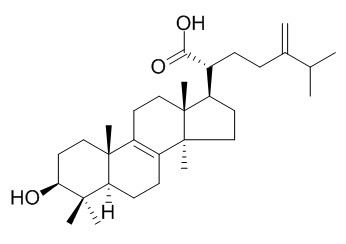Eburicoic acid
Eburicoic acid and TR2 have anti-inflammatory activity, the mechanism is related to the decrease of inflammatory cytokines and an increase of antioxidant enzyme activity, they protect the liver from CCl4-induced hepatic damage via antioxidant and anti-inflammatory mechanisms. Eburicoic acid has significant anti-liver cancer effects and more distinctive mechanisms.
Inquire / Order:
manager@chemfaces.com
Technical Inquiries:
service@chemfaces.com
Tel:
+86-27-84237783
Fax:
+86-27-84254680
Address:
1 Building, No. 83, CheCheng Rd., Wuhan Economic and Technological Development Zone, Wuhan, Hubei 430056, PRC
Providing storage is as stated on the product vial and the vial is kept tightly sealed, the product can be stored for up to
24 months(2-8C).
Wherever possible, you should prepare and use solutions on the same day. However, if you need to make up stock solutions in advance, we recommend that you store the solution as aliquots in tightly sealed vials at -20C. Generally, these will be useable for up to two weeks. Before use, and prior to opening the vial we recommend that you allow your product to equilibrate to room temperature for at least 1 hour.
Need more advice on solubility, usage and handling? Please email to: service@chemfaces.com
The packaging of the product may have turned upside down during transportation, resulting in the natural compounds adhering to the neck or cap of the vial. take the vial out of its packaging and gently shake to let the compounds fall to the bottom of the vial. for liquid products, centrifuge at 200-500 RPM to gather the liquid at the bottom of the vial. try to avoid loss or contamination during handling.
Cell Prolif.2021, 54(8):e13083.
Separations2023, 10(2), 131.
Toxicol Appl Pharmacol.2022, 434:115815.
Biochem Biophys Res Commun.2018, 495(1):1271-1277
Chinese Medicine2019, 14(1)
TCI CO.2019, US20190151281A1
Green Chemistry2021, ISSUE 2.
Asian Pac J Cancer Prev. 2020, 21(4):935-941.
Virulence.2018, 9(1):588-603
Food Chem.2019, 278:683-691
Related and Featured Products
J Agric Food Chem. 2013 May 29;61(21):5064-71.
Analgesic and anti-inflammatory bioactivities of eburicoic acid and dehydroeburicoic acid isolated from Antrodia camphorata on the inflammatory mediator expression in mice.[Pubmed:
23495748 ]
Eburicoic acid (TR1) and dehydroEburicoic acid (TR2), an active ingredient from Antrodia camphorata (AC) solid-state culture, were evaluated for analgesic and anti-inflammatory effects.
METHODS AND RESULTS:
Treatment with Eburicoic acid and TR2 significantly inhibited a number of acetic acid-induced writhing responses and formalin-induced pain in the late phase. In the anti-inflammatory test, Eburicoic acid and TR2 decreased paw edema at the fourth and fifth hour after λ-carrageenan (Carr) administration and increased the activities of catalase (CAT), superoxide dismutase (SOD), and glutathione peroxidase (GPx) in the paw edema tissue. We also demonstrated that Eburicoic acid and TR2 significantly attenuated the malondialdehyde (MDA), nitric oxide (NO), tumor necrosis factor (TNF-α), and interleukin-1β (IL-1β) levels in either edema paw or serum at the fifth hour after Carr injection. Western blotting revealed that Eburicoic acid and TR2 decreased Carr-induced inducible nitric oxide synthase (iNOS) and cycloxyclase (COX-2) expressions at the fifth hour in paw edema. Treatment with TR1 and TR2 also diminished neutrophil infiltration into the paw edema at the fifth hour.
CONCLUSIONS:
The present study suggests that the anti-inflammatory mechanisms of Eburicoic acid and TR2 might be related to the decrease of inflammatory cytokines and an increase of antioxidant enzyme activity.
J Tradit Complement Med. 2012 Oct;2(4):312-22.
Eburicoic Acid, an Active Triterpenoid from the Fruiting Bodies of Basswood Cultivated Antrodia cinnamomea, Induces ER Stress-Mediated Autophagy in Human Hepatoma Cells.[Pubmed:
24716146]
Antrodia cinnamomea, a Taiwan-specific medicinal mushroom, can manipulate biological activities, including hepatoprotection, anti-inflammation, anti-hepatitis B virus activity, anticancer activity, etc.
METHODS AND RESULTS:
In this study, the anti-liver cancer activity and molecular mechanisms of Eburicoic acid, the second most abundant triterpenoid from the fruiting bodies of basswood cultivated Antrodia cinnamomea was investigated using the human hepatoma Hep 3B cells. The results show that Eburicoic acid effectively reduced Hep 3B cell viability within 24 hours, and the IC50 was 18.4 μM, which was equivalent to 8.7 μg/mL. Besides, Eburicoic acid induced conversion of LC3-I to LC3-II and a large number of autophagosomes/autolysosomes formation. In depth investigation for the molecular mechanisms, revealed that Eburicoic acid firstly promoted reactive oxygen species generation and ATP depletion, leading to endoplasmic reticulum stress, followed by elevated cytosolic calcium ion concentration and BiP expression, downregulated phosphorylation of DAPK, upregulated phosphorylation of Beclin-1, JNK, and Bcl-2, and finally induced autophagy in Hep 3B cells.
CONCLUSIONS:
These results indicate that Eburicoic acid has significant anti-liver cancer effects and more distinctive mechanisms.
Food Chem. 2013 Dec 1;141(3):3020-7.
Hepatoprotective effects of eburicoic acid and dehydroeburicoic acid from Antrodia camphorata in a mouse model of acute hepatic injury.[Pubmed:
23871054]
The hepatoprotective effects of Eburicoic acid (TR1) and dehydroEburicoic acid (TR2) from Antrodia camphorata (AC) against carbon tetrachloride (CCl4)-induced liver damage were investigated in mice.
METHODS AND RESULTS:
Eburicoic acid and TR2 was administered intraperitoneally (i.p.) for 7 days prior to the administration of CCl4. Pretreatment with TR1 and TR2 prevented the elevation of aspartate aminotransferase (AST), alanine aminotransferase (ALT), and liver lipid peroxides in CCl4-treated mice. The activities of antioxidant enzymes [catalase (CAT), superoxide dismutase (SOD), and glutathione peroxidase (GPx)], nitric oxide (NO) production, and tumour necrosis factor-alpha (TNF-α) were decreased after the treatment with TR1 and TR2 in CCl4-treated mice. Western blotting revealed that Eburicoic acid and TR2 significantly decreased inducible nitric oxide synthase (iNOS) and cyclooxygenase-2 (COX-2) expressions and increased the expression of cytochrome P4502E1 (CYP2E1) in CCl4-treated mice.
CONCLUSIONS:
Therefore, we speculate that Eburicoic acid and TR2 protect the liver from CCl4-induced hepatic damage via antioxidant and anti-inflammatory mechanisms.



